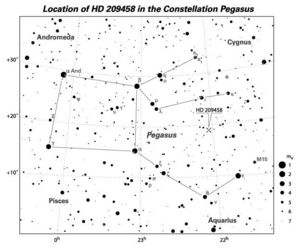HD 209458 (extrasolar planet)
HD 209458 is a 7th magnitude star in the constellation Pegasus, visible through binoculars or amateur telescopes, in which an extrasolar planet was discovered in 1999 as a result of observations involving a slight gravitational tug on the star. It is estimated to be about 70 percent the mass of the giant planet Jupiter, or 220 times more massive than Earth. The planet itself is invisible but the star is easy to find in Northern skies after sunset.
The Jupiter-sized planet orbits HD 209458, a yellow, Sun-like star that lies 150 light-years away. Its atmospheric composition was probed when the planet passed in front of its parent star, allowing astronomers for the first time ever to see light from the star filtered through the planet's atmosphere. Astronomers also used Hubble's "STIS" spectrometer to detect the presence of sodium, seeing less sodium than expected, and leading to one interpretation that high-altitude clouds in the alien atmosphere might have blocked some of the light.
Subsequently, astronomers found that the tilt of the planet's orbit makes it pass in front of the star, as seen from Earth. In that way it is unique among all the extra-solar planets discovered to date (there are approximately 400 of them). As the planet passes in front of the star, it causes the star to dim very slightly for the duration of the transit. Transit observations by Hubble and ground-based telescopes confirmed that the planet is primarily gaseous, rather than liquid or solid, meaning that it is a gas giant, like Jupiter and Saturn.
The planet is an ideal target for repeat observations because it transits the star every 3.5 days—which is the extremely short time it takes the planet to go around the star at a distance of merely four million miles (6.4 million km) from the stellar surface. This close proximity heats the planet's atmosphere to approximately 2,000 degrees Fahrenheit (1,100 degrees Celsius).
Links
| |||||
